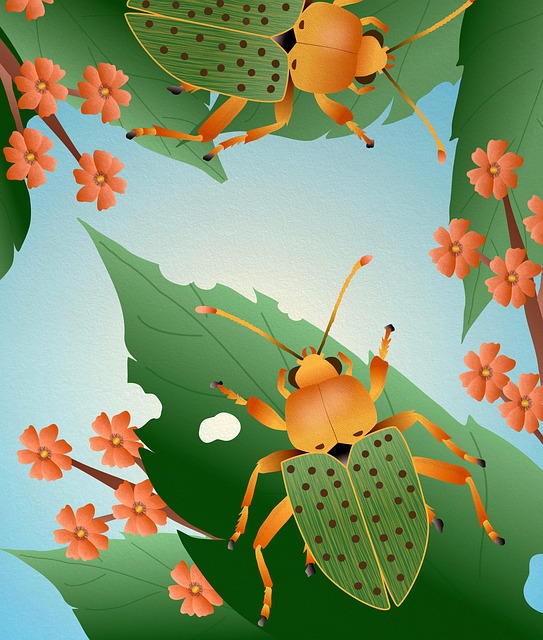Boxelder bugs (Boisea trivittata) are warm-region pests that feed on tree sap, especially from boxelder trees. Measuring 1/4 inch long with red to brown bodies marked by lines and spots, they cluster indoors during colder months drawn by light and heat. Early detection of these signs is crucial for effective boxelder bug extermination: defoliation, mold growth due to sticky honeydew secretion, and pinholes in tree bark indicate potential long-term damage if left untreated. A multi-method approach combining inspection, heat treatment, chemical applications, and natural repellents is recommended; regular maintenance like sealing entry points and keeping areas clean helps prevent future infestations.
Boxelder bugs (Boisea trivittata) are a common pest that can infiltrate homes and cause numerous problems. This article guides you through identifying boxelder bug infestations, focusing on their behavior, habitat, and common signs. Understanding these indicators is crucial for prompt action. Learn to recognize the damage they inflict and explore effective extermination methods tailored for these persistent pests, ensuring a peaceful living environment. Discover expert tips for successful boxelder bug extermination.
Understanding Boxelder Bugs: Behavior and Habitat
Boxelder bugs, scientifically known as Boisea trivittata, are a common pest in many regions, particularly during the warmer months. Understanding their behavior and habitat is crucial for identifying infestations early on. These insects prefer to live outdoors in areas with dense vegetation, such as trees, shrubs, and bushes. They are most active in late summer and fall when they feed on the sap of trees, especially boxelder trees, from which they get their name.
Boxelder bugs have a distinctive appearance with flat, oval-shaped bodies ranging from red to brown in color, often marked with dark lines and spots. They are about 1/4 inch long and can be found near entry points like windows and doors during the colder months when they seek shelter indoors. While they don’t typically cause significant damage to structures, their presence can be a nuisance and their ability to quickly multiply makes early detection vital for effective boxelder bug extermination.
Common Signs of a Boxelder Bug Infestation
Boxelder bugs, despite their unassuming appearance, can cause significant distress when they infest homes and properties. Recognizing the common signs of a boxelder bug infestation is crucial for prompt action and effective boxelder bug extermination. One of the most noticeable indicators is the presence of small, dark insects on windowsills, walls, and other indoor surfaces during the fall and winter months. These bugs are attracted to light and heat sources, often seeking shelter inside homes as temperatures drop.
Another telltale sign is the damage they cause to boxelder trees and nearby plants. Boxelder bugs feed on the sap of these trees, leading to visible discoloration, wilting leaves, and even branch dieback over time. Additionally, their cast skins and exoskeletons can create a fine, dust-like residue in infested areas, contributing to a distinct, unpleasant odor. Prompt identification of these signs allows for early intervention, preventing the infestation from escalating and ensuring effective boxelder bug extermination.
Identifying Boxelder Bug Damage
Boxelder bugs can cause noticeable damage to trees and plants, which can be a clear indication of an infestation. One of the most visible signs is defoliation, where leaves turn brown and drop prematurely. This is particularly evident in areas with a high concentration of boxelder trees. The bugs also excrete a sticky substance called honeydew, often leaving surfaces around infested trees coated and promoting mold growth.
Upon closer inspection, you may notice the presence of small pinholes in the bark of trees, which serve as entry points for these pests. These holes can lead to significant tree damage over time, especially if left untreated. Boxelder bug extermination methods are essential to prevent such destruction and ensure the health of your plants and trees.
Effective Boxelder Bug Extermination Methods
When it comes to effective boxelder bug extermination, timely action is crucial. These insects can quickly multiply and cause significant damage to homes and structures. The first step involves identifying their presence through common signs such as visible bugs, shed skins, or small holes in fabrics and materials. Once detected, several methods can be employed for successful extermination.
Professional pest control services often recommend a multi-pronged approach, starting with an inspection to pinpoint the extent of the infestation. Heat treatment, where specialized equipment raises the temperature to kill the bugs, is a popular method. Additionally, chemical applications targeted at their hiding places and entry points can be effective. Natural repellents like essential oils and plant-based solutions are also gaining popularity for those seeking eco-friendly options. Regular maintenance, including sealing entry points and keeping areas clean, plays a vital role in preventing future boxelder bug infestations.
Recognizing the signs of a boxelder bug infestation is key to effective boxelder bug extermination. By understanding their behavior, identifying common indicators like egg sacs and damaged property, and employing proven elimination methods, you can protect your space from these pests. Timely action is crucial, as prompt boxelder bug extermination prevents further spread and ensures a more comfortable living environment.
